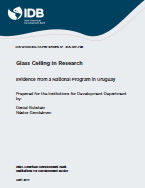Glass Ceiling in Research: Evidence from a National Program in Uruguay
Date
Apr 2017
This paper presents evidence that female researchers have 7.1 percentage points lower probability of being accepted into the largest national research support program in Uruguay than male researchers. They also have lower research productivity than their male counterparts. Differences in observable characteristics explain 4.9 of the 7.1 percentage point gap. The gender gap is wider at the higher ranks of the program consistent with the existence of a glass ceiling. The results are robust to issues of bidirectionality (impact of research productivity on the probability of accessing the program and impact of the program on research productivity), joint determination and correlation of variables (e.g. having a Ph.D., publishing, and tutoring), and initial productivity effects (positive results at early stages may have long-term effects on career development). The paper presents three hypotheses for the gender gap (an original sin in the organization of the system, biases in the composition of evaluation committees, and differences in field of concentration) and finds some evidence for each. Glass ceilings are stronger in the fields where women are overrepresented among the applicants to the system: medical sciences, natural sciences, and humanities. Finally, it presents a counterfactual distribution of the program in the absence of discriminatory treatment of women and discusses the economic costs of the gender gap.



